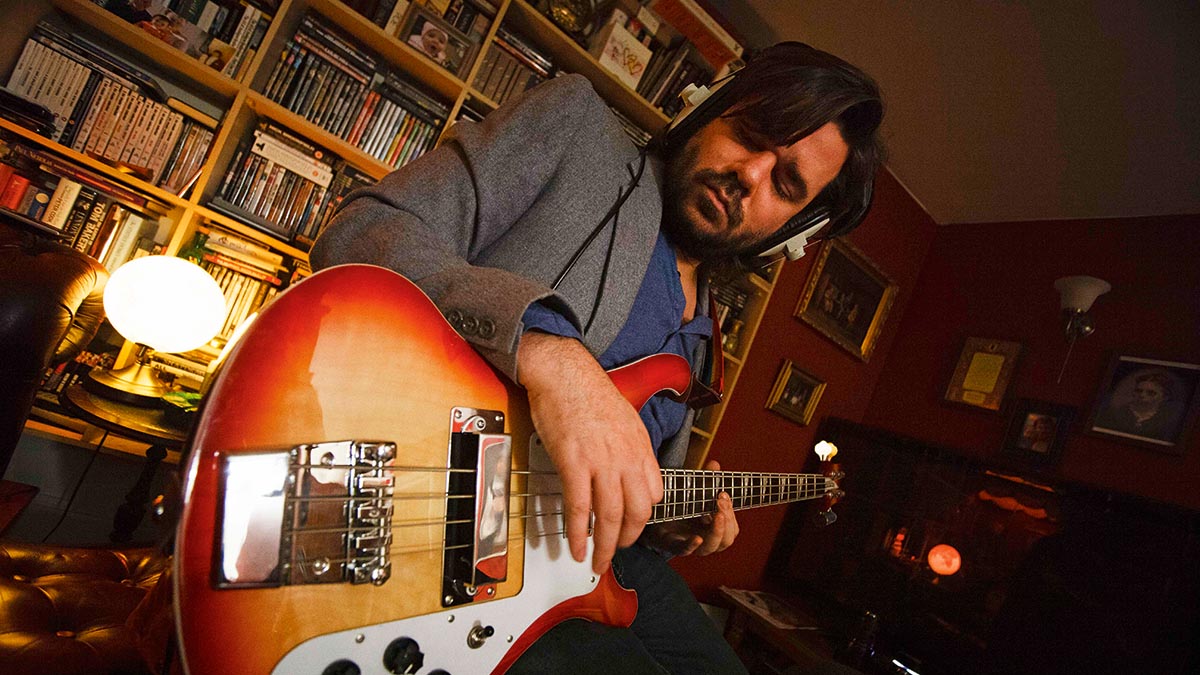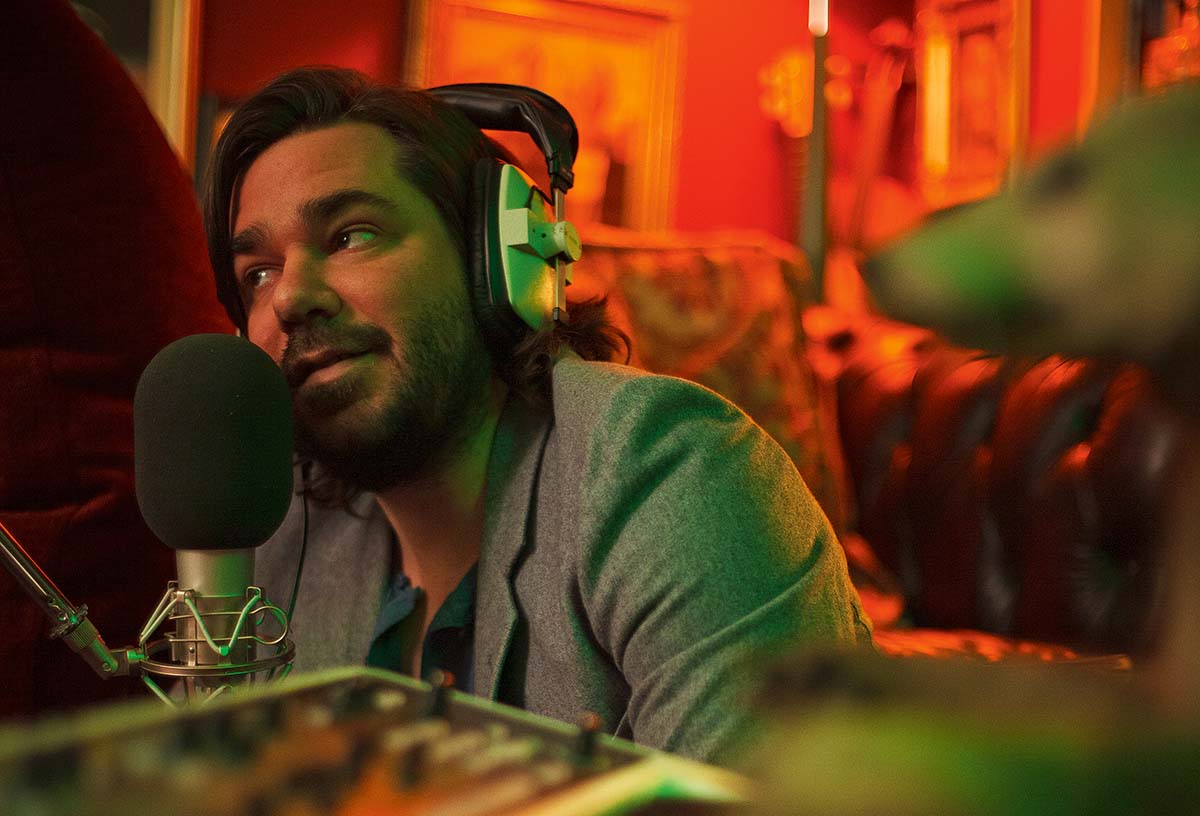Matt Berry: “I’m more interested in the songwriter-guitarists than the gymnasts. If you're sensitive enough as a guitarist then you'll be into songwriting“
The latest LP from the famed comedic TV actor and multi-instrumentalist is a complex Rickenbacker-infused affair in psychedelic color

Matt Berry is well known for his starring roles in UK TV comedy series such as The IT Crowd, Toast Of London and Year Of The Rabbit. But he is also a committed musician who’s released a string of acclaimed albums on the Acid Jazz label.
A multi-instrumentalist with a particular love for the guitar, Matt evokes everything from Dylan and early Floyd to Scott Walker on his recordings – but his latest, The Blue Elephant, is a psychedelic odyssey crafted from classic Rickenbacker tones captured the old-fashioned way with shrewd mic placement, not modelling. We join Matt to find out more about the elephant in the room…
Does The Blue Elephant mark a creative shift from your previous work on Acid Jazz?
“Well, it’s a big contrast to my last album, Phantom Birds, because what I wanted to do with that was produce something very sparse and simplistic. At most, there were three instruments being played at once, maybe four including the voice. So it was simple songs in that kind of John Wesley Harding way, where it’s just a guitar and a small rhythm section, and there’s hardly any overdubs. So that’s what I set out to do with the last one.
“But it’s like everything with me: the next thing I do, I want to do the exact opposite, whether it’s for TV or in music. And, also, because The Blue Elephant was done during a time when musicians couldn’t get together, I was intent on doing something a lot more complex, involving a lot more overdubs. So I would play everything and build it up that way, but still keep that '60s vibe to it.”
The songs segue together by way of short spoken-word interludes and crossfades, a little like Dark Side Of The Moon…
“It’s one of the most fun challenges to dovetail songs together. It’s as much of a thrill as when composers do overtures that are basically a short piece of music that covers all the melodies you’re about to hear… Well, this had the same sort of joy for me, in as far as I love to work out how to dovetail one song into another. And it can be done in all sorts of ways: it can be done with panning, it can be done with the key of the last chord – all of that kind of stuff.”
Get The Pick Newsletter
All the latest guitar news, interviews, lessons, reviews, deals and more, direct to your inbox!
The classic '60s and psychedelic guitar tones are really great. What were your go-to guitars for the album?
“I used Rickenbackers a lot because I wanted that characteristic sound and I can’t get that otherwise – I mean, you could possibly get something like it from a Tele if you amp it right, but I didn’t want to do that. I wanted the real thing. So there’s Rickenbacker 12-string electrics, Rickenbacker six-string electrics, lots of Strats and various Gibsons. And a Rickenbacker bass. That’s everything I used.”
I absolutely mic up amps, whether it’s guitar amps or organ amps. I’ve tried both mic’ing and modelling throughout the years and one is a lot more exciting to listen to than the other
As it was a one-man project, did you get the amplified tones from modelling devices for speed and flexibility of working?
“No way, I absolutely mic up amps, whether it’s guitar amps or organ amps. I’ve tried both [traditional mic’ing and modelling solutions] throughout the years and one is a lot more exciting to listen to than the other. To be fair, [modelling and plugin] technology is getting really good now – and obviously if you haven’t got a lot of space or have to keep the noise down… I get that. But if you don’t then I just think ‘stick a mic in front of stuff’.”
The album has a strong '60s vibe. Were any existing albums a touchstone for the sounds you created on The Blue Elephant?
“I haven’t gone out of my way to make something sound like something else. But, obviously, it is influenced by the things I like. So the answer is ‘not consciously’ and not as a nod to anything. I’m using the production techniques I like, which are borrowed from years gone by… so not consciously, I don’t think. Subconsciously, absolutely. Because you can’t help it.”
How do you keep musical ideas original and steer clear of pastiche when you’re working with '60s-style sounds?
“When I approach this stuff and when I’m recording this, it’s not pastiche. I’m not doing it as a joke; I’m doing it because they’re the techniques and the kind of sounds I really love. So I’m just using them to get a sound I’ve got in my head. As opposed to going, ‘Do you know what? I’m going to sound like Pink Floyd today.’ I’m not interested in that.
“There’s nothing to be gained from that because it’s already been done. I wanted to do something different with those colours. That’s the way I see it. I have a bunch of colours associated with psychedelia then it’s a case of using those colours – but doing your own thing with them.”
One positive thing about playing everything yourself is that you have an impartial ear when it comes to mixing – because everything’s you. You don’t think, ‘Well, that’s me on the guitar, I’m going to turn it up'
What are the pros and cons of recording an album where you’re playing almost all of the instruments yourself, as well as composing the material?
“One positive thing about playing everything yourself is that you have an impartial ear when it comes to mixing – because everything’s you. You don’t think, ‘Well, that’s me on the guitar, I’m going to turn it up a bit so I’m louder than everything else.’ So I think that’s useful. There’s a bunch of things that aren’t useful, too, though. I find you tend to put too many overdubs down because there isn’t anyone there going, ‘Do you really need all that?’
“It’s a good idea to go away and come back to what you were doing after a break from it. Give it a couple of days and then go back and sometimes you might come back with fresh ears and go, ‘You know what? All of that is ridiculous. I’m just going to get rid of all of that…’ That is useful to do. But it’s a bit more difficult [to evaluate the quality of the work] when you’re doing it all yourself.”

Which guitarists have most inspired your style on the instrument and on the album?
“Mike Oldfield is an obvious answer: he was the first one that I heard using dynamics. Apart from Albatross, I hadn’t heard a guitar be in the background, then in the foreground, slightly to the side and really dry and really wet all on the same song… Mike Oldfield was the first one to really make the most of that, for me. And that was very inspiring. And in terms of note selection, there’s Gilmour… I know that it’s such an obvious and boring thing to say, but, you know, I still listen to his guitar playing.
“But there are other people – you know, there’s Mark Day from Happy Mondays; he was a huge influence on the way that I played. He sounded like somebody who couldn’t play the guitar but was standing right in front of you and didn’t give a fuck. It’s the same with Robert Smith: it’s not about how quickly or how well he played, it’s just a song thing.
“So I think in terms of technique and colour, I would say Mike Oldfield, but in general I’m more interested in the songwriter-guitarists rather than the gymnasts. If you are sensitive enough as a guitarist then you will be into songwriting and how songwriters voice their ideas. I mean, I watch Dan [Steinhardt] on That Pedal Show and he’s nearly in tears sometimes when people come and play. And that is one of the most beautiful things I’ve ever seen. I love the fact that he gets affected by it.”
- The Blue Elephant is out now via Acid Jazz Records.
Jamie Dickson is Editor-in-Chief of Guitarist magazine, Britain's best-selling and longest-running monthly for guitar players. He started his career at the Daily Telegraph in London, where his first assignment was interviewing blue-eyed soul legend Robert Palmer, going on to become a full-time author on music, writing for benchmark references such as 1001 Albums You Must Hear Before You Die and Dorling Kindersley's How To Play Guitar Step By Step. He joined Guitarist in 2011 and since then it has been his privilege to interview everyone from B.B. King to St. Vincent for Guitarist's readers, while sharing insights into scores of historic guitars, from Rory Gallagher's '61 Strat to the first Martin D-28 ever made.
“It was tour, tour, tour. I had this moment where I was like, ‘What do I even want out of music?’”: Yvette Young’s fretboard wizardry was a wake-up call for modern guitar playing – but with her latest pivot, she’s making music to help emo kids go to sleep
“There are people who think it makes a big difference to the sound. Stevie always sounded the same whether it was rosewood or maple”: Jimmie Vaughan says your fretboard choice doesn’t matter – and SRV is his proof








![John Mayer and Bob Weir [left] of Dead & Company photographed against a grey background. Mayer wears a blue overshirt and has his signature Silver Sky on his shoulder. Weir wears grey and a bolo tie.](https://cdn.mos.cms.futurecdn.net/C6niSAybzVCHoYcpJ8ZZgE.jpg)

![A black-and-white action shot of Sergeant Thunderhoof perform live: [from left] Mark Sayer, Dan Flitcroft, Jim Camp and Josh Gallop](https://cdn.mos.cms.futurecdn.net/am3UhJbsxAE239XRRZ8zC8.jpg)
